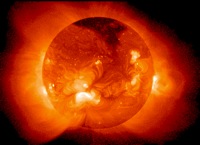Difference between revisions of "Solar energy"
m (Text replacement - "http://nordan.daynal.org" to "https://nordan.daynal.org") |
|||
| Line 5: | Line 5: | ||
Solar powered [[electrical]] generation relies on [[heat]] engines and [http://en.wikipedia.org/wiki/Photovoltaics photovoltaics]. Solar energy's uses are [[limited]] only by [[human]] [[Invention|ingenuity]]. A partial list of solar [[applications]] includes space heating and cooling through [http://en.wikipedia.org/wiki/Solar_architecture solar architecture], [http://en.wikipedia.org/wiki/Potable_water potable water] via distillation and disinfection, [http://en.wikipedia.org/wiki/Daylighting daylighting], [http://en.wikipedia.org/wiki/Solar_hot_water solar hot water], [http://en.wikipedia.org/wiki/Solar_cooking solar cooking], and high [[temperature]] [[process]] [[heat]] for industrial purposes.To [[harvest]] the solar energy, the most common way is to use [http://en.wikipedia.org/wiki/Solar_panel solar panels]. | Solar powered [[electrical]] generation relies on [[heat]] engines and [http://en.wikipedia.org/wiki/Photovoltaics photovoltaics]. Solar energy's uses are [[limited]] only by [[human]] [[Invention|ingenuity]]. A partial list of solar [[applications]] includes space heating and cooling through [http://en.wikipedia.org/wiki/Solar_architecture solar architecture], [http://en.wikipedia.org/wiki/Potable_water potable water] via distillation and disinfection, [http://en.wikipedia.org/wiki/Daylighting daylighting], [http://en.wikipedia.org/wiki/Solar_hot_water solar hot water], [http://en.wikipedia.org/wiki/Solar_cooking solar cooking], and high [[temperature]] [[process]] [[heat]] for industrial purposes.To [[harvest]] the solar energy, the most common way is to use [http://en.wikipedia.org/wiki/Solar_panel solar panels]. | ||
| − | Solar [[technologies]] are broadly characterized as either [http://en.wikipedia.org/wiki/Passive_solar passive solar] or [http://en.wikipedia.org/wiki/Active_solar active solar] depending on the way they capture, [[convert]] and [[distribute]] solar energy. Active solar [[techniques]] include the use of photovoltaic panels and [http://en.wikipedia.org/wiki/Solar_thermal_energy solar thermal collectors] to harness the [[energy]]. Passive solar techniques include [[orienting]] a building to the [[Sun]], selecting [[materials]] with favorable [http://en.wikipedia.org/wiki/Thermal_mass thermal mass] or [[light]] [ | + | Solar [[technologies]] are broadly characterized as either [http://en.wikipedia.org/wiki/Passive_solar passive solar] or [http://en.wikipedia.org/wiki/Active_solar active solar] depending on the way they capture, [[convert]] and [[distribute]] solar energy. Active solar [[techniques]] include the use of photovoltaic panels and [http://en.wikipedia.org/wiki/Solar_thermal_energy solar thermal collectors] to harness the [[energy]]. Passive solar techniques include [[orienting]] a building to the [[Sun]], selecting [[materials]] with favorable [http://en.wikipedia.org/wiki/Thermal_mass thermal mass] or [[light]] [https://nordan.daynal.org/wiki/images/Light_dispersion_conceptual.gif dispersing] properties, and [[designing]] spaces that [[naturally]] [[circulate]] air. |
==Energy from the Sun== | ==Energy from the Sun== | ||
The [[Earth]] receives 174 [http://en.wikipedia.org/wiki/Orders_of_magnitude_(power)#petawatt_.281015_watts.29 petawatts] (PW) of incoming solar [[radiation]] (insolation) at the upper [[atmosphere]]. Approximately 30% is [[reflected]] back to [[space]] while the rest is absorbed by clouds, [[oceans]] and land masses. The [[spectrum]] of solar light at the [[Earth]]'s [[surface]] is mostly spread across the [[visible]] and [http://en.wikipedia.org/wiki/Near-infrared near-infrared] ranges with a small part in the [http://en.wikipedia.org/wiki/Near-ultraviolet near-ultraviolet]. | The [[Earth]] receives 174 [http://en.wikipedia.org/wiki/Orders_of_magnitude_(power)#petawatt_.281015_watts.29 petawatts] (PW) of incoming solar [[radiation]] (insolation) at the upper [[atmosphere]]. Approximately 30% is [[reflected]] back to [[space]] while the rest is absorbed by clouds, [[oceans]] and land masses. The [[spectrum]] of solar light at the [[Earth]]'s [[surface]] is mostly spread across the [[visible]] and [http://en.wikipedia.org/wiki/Near-infrared near-infrared] ranges with a small part in the [http://en.wikipedia.org/wiki/Near-ultraviolet near-ultraviolet]. | ||
Revision as of 22:42, 12 December 2020
Solar energy, radiant light and heat from the sun, has been harnessed by humans since ancient times using a range of ever-evolving technologies. Solar radiation, along with secondary solar-powered resources such as wind and wave power, hydroelectricity and biomass, account for most of the available renewable energy on earth. Only a minuscule fraction of the available solar energy is used.
Solar powered electrical generation relies on heat engines and photovoltaics. Solar energy's uses are limited only by human ingenuity. A partial list of solar applications includes space heating and cooling through solar architecture, potable water via distillation and disinfection, daylighting, solar hot water, solar cooking, and high temperature process heat for industrial purposes.To harvest the solar energy, the most common way is to use solar panels.
Solar technologies are broadly characterized as either passive solar or active solar depending on the way they capture, convert and distribute solar energy. Active solar techniques include the use of photovoltaic panels and solar thermal collectors to harness the energy. Passive solar techniques include orienting a building to the Sun, selecting materials with favorable thermal mass or light dispersing properties, and designing spaces that naturally circulate air.
Energy from the Sun
The Earth receives 174 petawatts (PW) of incoming solar radiation (insolation) at the upper atmosphere. Approximately 30% is reflected back to space while the rest is absorbed by clouds, oceans and land masses. The spectrum of solar light at the Earth's surface is mostly spread across the visible and near-infrared ranges with a small part in the near-ultraviolet.
Earth's land surface, oceans and atmosphere absorb solar radiation, and this raises their temperature. Warm air containing evaporated water from the oceans rises, causing atmospheric circulation or convection. When the air reaches a high altitude, where the temperature is low, water vapor condenses into clouds, which rain onto the Earth's surface, completing the water cycle. The latent heat of water condensation amplifies convection, producing atmospheric phenomena such as wind, cyclones and anti-cyclones. Sunlight absorbed by the oceans and land masses keeps the surface at an average temperature of 14 °C.[4] By photosynthesis green plants convert solar energy into chemical energy, which produces food, wood and the biomass from which fossil fuels are derived.
The total solar energy absorbed by Earth's atmosphere, oceans and land masses is approximately 3,850,000 exajoules (EJ) per year. In 2002, this was more energy in one hour than the world used in one year. Photosynthesis captures approximately 3,000 EJ per year in biomass. The amount of solar energy reaching the surface of the planet is so vast that in one year it is about twice as much as will ever be obtained from all of the Earth's non-renewable resources of coal, oil, natural gas, and mined uranium combined.[1]
